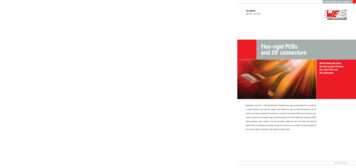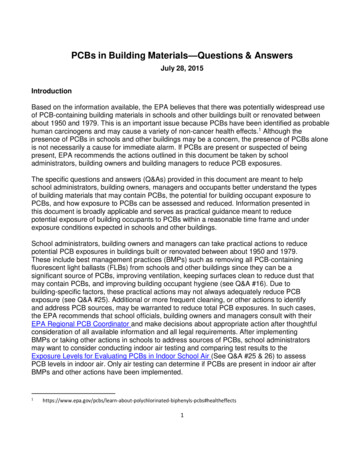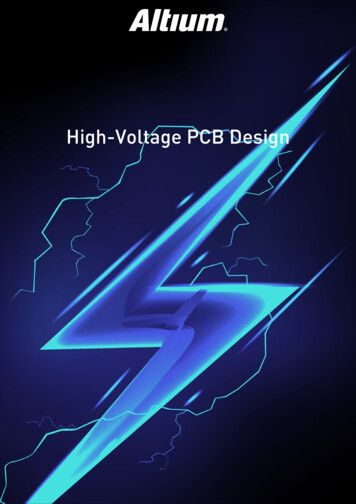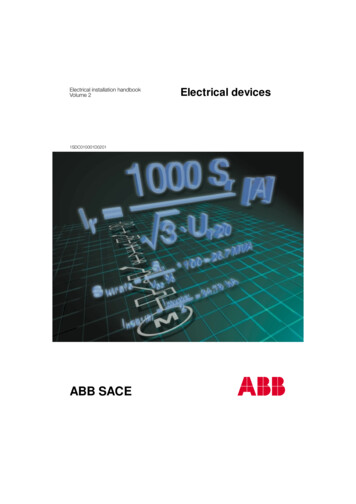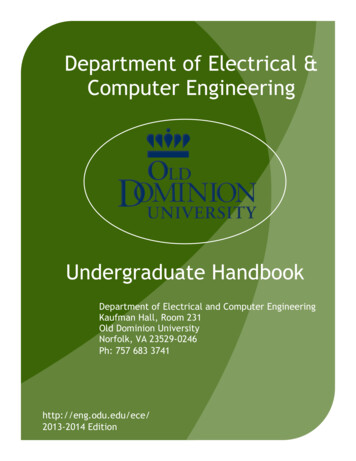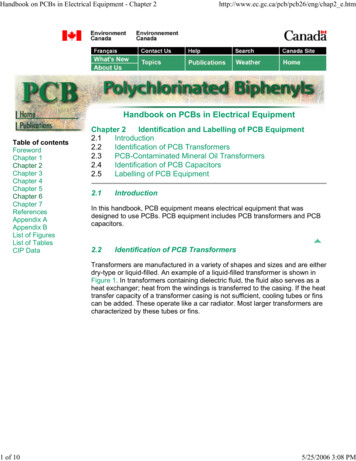
Transcription
Handbook on PCBs in Electrical Equipment - Chapter 2http://www.ec.gc.ca/pcb/pcb26/eng/chap2 e.htmHandbook on PCBs in Electrical EquipmentTable of contentsForewordChapter 1Chapter 2Chapter 3Chapter 4Chapter 5Chapter 6Chapter 7ReferencesAppendix AAppendix BList of FiguresList of TablesCIP Data1 of 10Chapter 2Identification and Labelling of PCB Equipment2.1Introduction2.2Identification of PCB Transformers2.3PCB-Contaminated Mineral Oil Transformers2.4Identification of PCB Capacitors2.5Labelling of PCB Equipment2.1IntroductionIn this handbook, PCB equipment means electrical equipment that wasdesigned to use PCBs. PCB equipment includes PCB transformers and PCBcapacitors.2.2Identification of PCB TransformersTransformers are manufactured in a variety of shapes and sizes and are eitherdry-type or liquid-filled. An example of a liquid-filled transformer is shown inFigure 1. In transformers containing dielectric fluid, the fluid also serves as aheat exchanger; heat from the windings is transferred to the casing. If the heattransfer capacity of a transformer casing is not sufficient, cooling tubes or finscan be added. These operate like a car radiator. Most larger transformers arecharacterized by these tubes or fins.5/25/2006 3:08 PM
Handbook on PCBs in Electrical Equipment - Chapter 22 of 10http://www.ec.gc.ca/pcb/pcb26/eng/chap2 e.htmFigure 1 Liquid-filled TransformerPad-mountedmay contain askarelTransformers can be found in a number of locations (Figure 2), i.e.:a. Indoorsi.ii.iii.iv.mounted on a wall or column,in an electrical room or fenced enclosure,within fire-proof vaults, andin mines and underground vaults.b. Outdoorsi. on a roof,ii. on a concrete pad, andiii. on a utility pole.Figure 2 Typical Transformer LocationsIndoor liquid-filled transformers must be nonflammable unless they areinstalled in a fireproof vault approved by the electrical inspection authorities.PCBs have very low flammability and were considered ideal for use in indoor5/25/2006 3:08 PM
Handbook on PCBs in Electrical Equipment - Chapter 23 of 10http://www.ec.gc.ca/pcb/pcb26/eng/chap2 e.htmliquid-filled transformers. Consequently, transformers of the type installedindoors prior to 1979, in locations other than fireproof vaults, often containPCBs.Not all transformers contain PCBs; the following procedures can be used todetermine which transformers contain PCBs and which ones do not. First, aliquid-filled transformer may or may not have a conservator tank(see Figure 3). Any transformer that was manufactured in North America witha conservator tank was not designed to use PCBs and probably containsmineral oil. Second, a transformer's nameplate, attached to the outside of thetransformer casing, should be checked for information about the fluid content.If the type designation on the nameplate starts with the letter 0, such as ONS,ONAN, ONWF, etc., the transformer is filled with mineral oil. If the typedesignation on the nameplate starts with the letter L, such as LNAN, LNAF,LNWF, etc., the transformer is filled with nonflammable or flame-retardantliquid. Most of the "L" transformers manufactured before 1979 are PCBtransformers. Some of the "L" transformers manufactured before 1979 and all"L" transformers manufactured in or after 1979 were originally filled withflame-retardant liquid such as silicone or other alternative non-PCB fluidsdescribed in Chapter 4 of this handbook. Some nameplates specify the brandof cooling liquid inside the transformer. If one of the brand names listed inTable 1 appears on the nameplate, the transformer contains PCBs.Sometimes the nameplate does not provide information on the fluid content, inwhich case the manufacturer or Environment Canada can be contacted foradditional information.5/25/2006 3:08 PM
Handbook on PCBs in Electrical Equipment - Chapter 24 of 10http://www.ec.gc.ca/pcb/pcb26/eng/chap2 e.htmFigure 3 Liquid-filled Transformer with Conservator TankAskarel can be distinguished from other fluids, such as mineral oil, by physicalcharacteristics. The most obvious difference is the strong odour of askarels,due primarily to the tri- and tetrachlorobenzenes (TTCBs) contained in them.Physical characteristics useful in the identification of askarels are listed inTable 2; however, a proper laboratory test is the best way to obtain positiveconfirmation.Table 2 Physical Characteristics of AskarelColourDensityOdourTextureVapourscrystal clear to pale yellowdenser than waterbitter smellsomewhat slipperyinvisibleUsed askarel does not usually have the same appearance as new askarel. Itcan become contaminated with dirt, moisture, black carbon particles (fromarcing) and pieces of insulation from inside the equipment. Contamination5/25/2006 3:08 PM
Handbook on PCBs in Electrical Equipment - Chapter 25 of 10http://www.ec.gc.ca/pcb/pcb26/eng/chap2 e.htmdegrades the performance of askarel and clouds or darkens its appearance.2.3PCB-contaminated Mineral Oil TransformersMineral oil-filled transformers were not designed to use PCBs but many ofthem have been found to be contaminated with PCBs in concentrationsexceeding 50 ppm. Several possible explanations have been advanced toaccount for this finding:i. transformer plants producing both PCB and non-PCB transformers mayhave used common filling equipment for both;ii. askarel may have been used as a make-up fluid for mineral oil-filledequipment; oriii. equipment may have been used for servicing both askarel and mineraloil transformers without proper cleaning.PCB-contaminated mineral oil transformers are not the focus of this handbook.However, they are subject to regulations which also apply to PCBtransformers. The Chlorobiphenyl Regulations No. 3 (Release) prohibit therelease of PCBs in quantities exceeding 1 g per day from any transformermanufactured in or imported into Canada prior to July 1, 1980, and inconcentrations above 50 ppm for transformers manufactured or imported afterthat date. Provincial regulations and control criteria might also apply toout-of-service or stored PCB-contaminated mineral oil transformers.If there is uncertainty about the PCB concentration of a mineral oil-filledtransformer, a sample should be taken for analysis (it may be necessary toacquire professional services for the removal of transformer fluid samples).Field test kits can be used to determine whether or not a sample of mineral oilcontains PCBs in a concentration greater than a specified amount, such as 50ppm. Many of these kits are easy to use and give quick results, employing asimple colour transformation that indicates whether PCBs are present in aconcentration greater or less than the specified amount. These kits shouldonly be employed as a preliminary screening tool. Samples that test positivewith a kit should be sent to a laboratory for confirmatory analysis using gaschromatography.Treatment technologies have been developed to reduce or eliminate PCBcontamination in dielectric fluids such as mineral oil. Several processes for thetreatment of contaminated mineral oil have been introduced commercially.These processes are mobile and are designed for either on-line continuous orbatch treatment. Additional information can be found in the "Manual for theManagement of Wastes Containing Polychlorinated Biphenyls" (EnvironmentCanada, 1987).2.4Identification of PCB CapacitorsCapacitors have a number of uses, including:i. power factor correction, to achieve more efficient operation of ACinduction motors, furnaces and other inductive loads;5/25/2006 3:08 PM
Handbook on PCBs in Electrical Equipment - Chapter 26 of 10http://www.ec.gc.ca/pcb/pcb26/eng/chap2 e.htmii. starting aid for single phase motors;iii. surge protection for both electronic and power equipment, such aslarge motors;iv. voltage regulation for power lines; and,v. lamp ballasts for fluorescent and high intensity discharge light sources.Capacitors vary in size considerably, from the size of an ice cube to muchlarger than a refrigerator. They can often be recognized by the letters kVarstamped on their nameplates. These letters indicate the electrical rating of acapacitor which most often falls within the 5 kVar to 200 kVar range.Capacitors can be found in both indoor (Figure 4) and outdoor locations,usually installed in cool, dry areas to allow for efficient operation. Capacitorslocated outdoors are usually enclosed in a weatherproof welded, steel housingof rectangular construction. Capacitors may be found in a variety of locationswithin a building:i. in the plant area, wired to bus bars feeding a row of motors or electricwelders;ii. wired to the electrical terminals of AC motors (if 30 horsepower orlarger), electric welders and induction furnaces;iii. connected to motor control centre panels; andiv. connected to the main service cables inside the electrical room.Figure 4 Typical Indoor CapacitorsPractically all liquid-dielectric AC power capacitors manufactured between1930 and 1977 contain PCBs. In general, capacitors contain much smalleramounts of PCBs per unit than transformers. A PCB capacitor measuring10 cm x 10 cm x 25 cm would contain approximately 1 kg of PCBs and eventhe largest (200 kVar) power factor correction capacitor contains only about 80kg of PCBs. Most of the PCBs are absorbed in the paper or other soliddielectric material. Non-PCB capacitors manufactured after 1978 are oftenmarked: "No PCBs" or "Non-PCB Capacitor". Capacitors containing thedielectric fluids WEMCOL, FARADOL 100, DIELEKTRO II or DPO (asspecified on nameplates) do not contain PCBs. All other AC power capacitors5/25/2006 3:08 PM
Handbook on PCBs in Electrical Equipment - Chapter 27 of 10http://www.ec.gc.ca/pcb/pcb26/eng/chap2 e.htmmust be assumed to contain PCBs. Capacitors, unlike transformers, areusually hermetically sealed and analysis of the fluid for PCB content is notpractical.PCB capacitors found in lamp ballasts constitute a special case because oftheir small size and relative inaccessability. These capacitors are usuallyencapsulated in an asphalt-type compound in a steel enclosure installedinside the lighting fixture. Ballasts for high intensity discharge lamps are oftenmounted remotely from light fixtures. A typical capacitor utilized in afluorescent lamp ballast contains only about 25 g of PCBs. PCB capacitors inhigh intensity discharge lamps contain significantly more, usually about 300 g.Since 1978, fluorescent lamp ballasts have been manufactured without PCBcapacitors. Environment Canada's "Identification of Fluorescent Lamp BallastsContaining PCBs" (1986) provides useful information for evaluating ballasts.2.5Labelling of PCB EquipmentEnvironment Canada has developed a labelling system for PCB equipment inorder to:i. provide immediate identification of PCB equipment; andii. facilitate the development of a national inventory of PCB equipment,i.e., PCB capacitors and askarel transformers.The inventory assists in keeping track of the current locations of PCBequipment and could be useful in developing a PCB phaseout strategy in thefuture. Whenever PCB equipment is removed from service and placed instorage or otherwise disposed of, the nearest office of Environment Canadashould be notified (see Appendix B).All equipment that contains PCBs in concentrations greater than 50 ppmshould be labelled as a precautionary measure for users of the equipment andas a reminder that it must be treated as PCB-contaminated waste when takenout of service. Although the labelling of in-service PCB equipment is voluntary,industry has largely co-operated with this program.Two labels (Figure 5) are available for in-service equipment designed to usePCBs.These labels are serialized and have individual registration numbers at thebottom. The label shown in Figure 5a measures 15 cm x 15 cm and should beused on askarel transformers. The label shown in Figure 5b measures7.6 cm x 7.6 cm and should be used for labelling capacitors. Where a numberof capacitors are found together, such as in a capacitor bank, one label maybe used for the entire group regardless of the size of the individual capacitors;however, when a capacitor is removed from the bank for disposal it should belabelled. Equipment that contains PCB capacitors, e.g., radio transmitters andfluorescent lamp ballasts, does not have to be labelled. Labelling is advised,however, if the capacitors in such equipment are accessible and large enoughto be labelled.Figure 5 Serialized Labels for PCB Equipment5/25/2006 3:08 PM
Handbook on PCBs in Electrical Equipment - Chapter 28 of 10http://www.ec.gc.ca/pcb/pcb26/eng/chap2 e.htmFigure 5a) Label for Large Equipment (e.g., Transformers)Figure 5b) Label for Small Equipment (e.g., Capacitors)A non-serialized version of the 15 cm x 15 cm label is available (Figure 6) andshould be used as a general warning label and placed in a clearly visibleposition at entrances to locations where PCB equipment is found. Suchlocations, most often containing drums of waste, include fenced storagecompounds, electrical rooms and transformer vaults.5/25/2006 3:08 PM
Handbook on PCBs in Electrical Equipment - Chapter 29 of 10http://www.ec.gc.ca/pcb/pcb26/eng/chap2 e.htmFigure 6 Unserialized PCB Warning LabelA warning label has been developed specifically for PCB-contaminatedequipment (Figure 7). When a piece of equipment is suspected of beingcontaminated with PCBs, and if an activity is to be carried out to which theregulations apply, then it would be highly advisable to analyse the fluid forPCB content. If PCBs are found, a warning label should be placed on theequipment. This label provides space for entry of: PCB concentration, date ofanalysis, company name and the signature of an authorized company official.Figure 7 Warning Label For Pcb-Contaminated EquipmentAll of the labels discussed above are available from the regional offices ofEnvironment Canada (see Appendix B). What's New About Us Topics Publications Weather Home 5/25/2006 3:08 PM
Handbook on PCBs in Electrical Equipment - Chapter 210 of 10http://www.ec.gc.ca/pcb/pcb26/eng/chap2 e.htm Français Contact Us Help Search Canada Site The Green LaneTM, Environment Canada's World Wide Web siteLast updated: 2003-05-05Important NoticesLast reviewed: 2003-05-05URL of this page: http://www.ec.gc.ca/pcb/pcb26/eng/chap2 e.htm5/25/2006 3:08 PM
Transformers are manufactured in a variety of shapes and sizes and are either dry-type or liquid-filled. An example of a liquid-filled transformer is shown in Figure 1. In transformers containing dielectric fluid, the fluid also serves as a heat exchanger; heat fr
